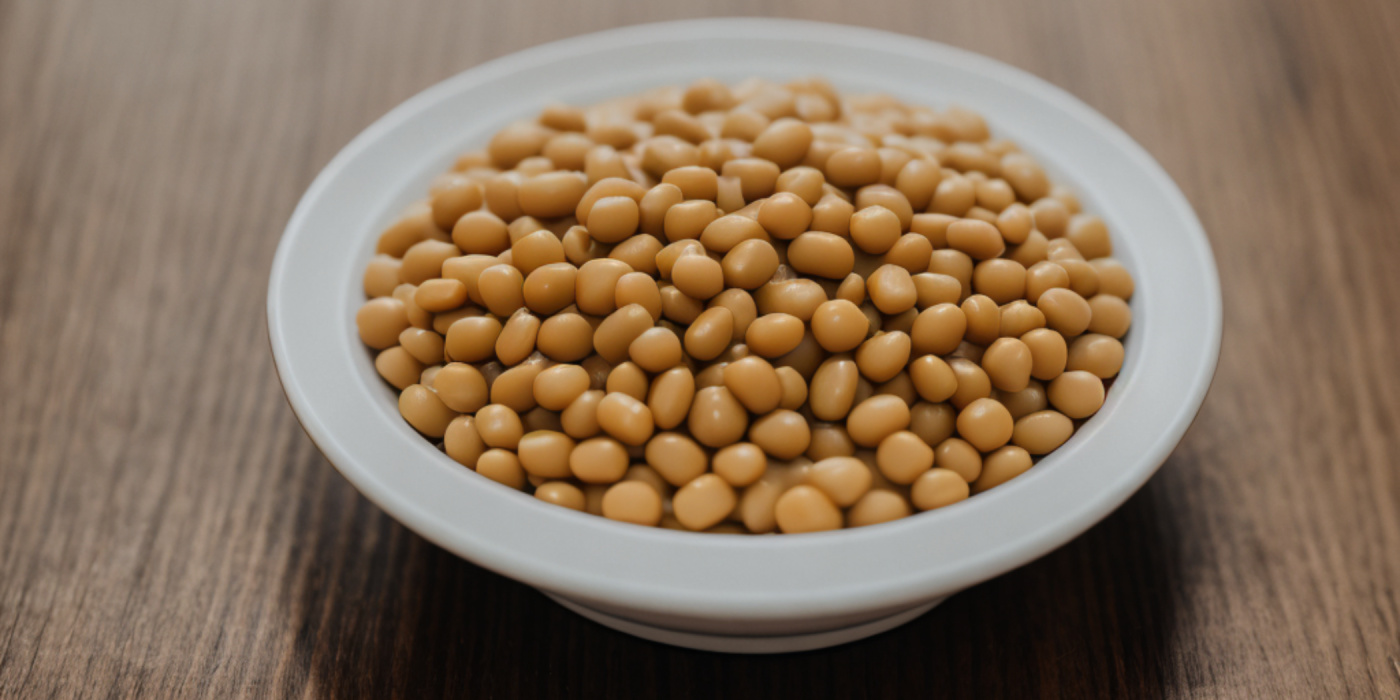Natto Knowledge: Nutrition, Health Benefits, and a DIY Recipe Guide

Natto, a unique Japanese dish renowned for its distinctive taste and texture, has a long-standing history as a staple in Asian cuisine. This fermented food, made from soybeans, is often heralded for its remarkable nutritional profile and associated health benefits, making it a popular choice for health enthusiasts worldwide.
Understanding Natto
Dating back over a thousand years, natto has its roots in Japan, where it's traditionally enjoyed as a breakfast dish. The process of its production involves the fermentation of soybeans using a specific type of bacterium called Bacillus subtilis var. natto. This microorganism imparts the beans with their characteristic stringy texture and a complex blend of flavours that can be a little bit of an acquired taste for those unfamiliar with it.
Throughout its history, natto has been valued not only as a versatile culinary ingredient but also for its nutritional significance. With its rich content of protein, vitamins, and minerals, along with beneficial probiotic properties, it has drawn the attention of dieticians and health experts globally.
This article aims to explore the world of natto in depth. We'll break down its nutritional profile, delineate the health benefits that it may offer, and even guide you through a straightforward recipe to make your own natto at home. Additionally, we'll tackle some frequently asked questions surrounding this remarkable food.
From its taste to its storability, we will examine all you need to know about this mighty fermented food. Whether you're a seasoned natto enthusiast or a curious newcomer, this comprehensive guide is here to help you navigate the ins and outs of natto. So, let's embark on this journey of discovery.
Before we delve into the ins and outs of natto's nutritious profile and health benefits, it's important to fully grasp what this fermented delicacy entails.
What is Natto?
Natto is a traditional Japanese dish that has been enjoyed for centuries. Its main ingredient is soybeans, which are small, round legumes with a subtle flavour and creamy texture. These beans are fermented using a specific type of bacterium known as Bacillus subtilis natto, which gives natto its distinctive characteristics.
Upon first encounter, natto may raise some eyebrows due to its unique appearance, aroma, and taste. The fermented beans develop a sticky, slimy consistency and a strong, pungent smell, somewhat akin to a strong cheese. The taste is often described as savoury, nutty, and slightly tangy. Natto is often enjoyed with rice, added to sushi, or even eaten on its own as a protein-packed snack.
The Fermentation Process
The magic behind natto lies in the art of fermentation. The process begins with the soaking and boiling of soybeans. Once the beans are properly cooked, they are mixed with a small amount of natto from a previous batch, which contains the necessary Bacillus subtilis natto. This mixture is then kept in a warm environment, usually around 40 degrees Celsius, for up to 24 hours. During this time, the bacteria ferments the soybeans, transforming them into natto.
The result is a food that not only has a completely transformed texture and flavour, but also a boosted nutritional profile. The fermentation process increases the bioavailability of nutrients in the soybeans and introduces beneficial probiotics, making natto a healthful addition to many diets.
Nutritional Content of Natto
In this section, we will delve into the robust nutritional profile of natto, covering the macronutrients it provides, the vitamins it's rich in, the minerals it contains, and the probiotics it houses.
Macronutrients in Natto
Natto is particularly rich in protein, making it an excellent plant-based protein source. It contains all nine essential amino acids, thus providing a complete protein source. Additionally, it has a notable amount of carbohydrates, particularly dietary fibre, which aids digestion. While natto does contain fat, it's mostly in the form of heart-healthy polyunsaturated fats.
Vitamins in Natto
One of natto's standout features is its high vitamin content, particularly vitamin K2 and B vitamins. Vitamin K2, not commonly found in many foods, plays an essential role in bone health and cardiovascular function. Natto also boasts an array of B vitamins, including B2, B6, and notably B12, a vitamin often lacking in vegan and vegetarian diets.
Minerals in Natto
Natto is a veritable treasure trove of minerals. It contains substantial amounts of calcium and iron, two minerals essential for overall health. Additionally, it is a source of other important minerals like potassium, which is essential for heart health, and magnesium, needed for countless biochemical reactions in the body.
Probiotics and Enzymes in Natto
Finally, the fermentation process that creates natto also produces a rich array of probiotics, primarily Bacillus subtilis, which promotes gut health. Natto is also known for its unique enzymatic activity, specifically the enzyme nattokinase, which has been studied for its potential cardiovascular benefits.
Unveiling the Health Benefits of Natto
Natto, a traditional Japanese food, brings with it a cornucopia of health benefits, thanks to its unique fermentation process and nutrient profile. Let's delve into these potential health benefits that could be derived from this nutritional powerhouse.
Enhancing Bone Health
Natto is a fantastic source of vitamin K2, a nutrient vital for bone health. Vitamin K2 plays a crucial role in the process of calcium regulation within the body, guiding calcium to the areas where it's most needed, like the bones and teeth, and keeping it away from areas it could cause harm, like the arteries. This makes natto a valuable ally for maintaining and enhancing bone health.
Supporting Cardiovascular Health
Natto's cardiovascular benefits are twofold. Firstly, the high vitamin K2 content helps prevent the calcification of arteries, potentially reducing the risk of heart disease. Additionally, the enzyme nattokinase, produced during the fermentation process, is believed to have heart-healthy properties by promoting blood flow and reducing blood clot formation.
Boosting Gut Health and Digestion
Being a fermented food, natto hosts a variety of beneficial bacteria, contributing to a healthy gut microbiome. These friendly bacteria aid in the digestion process, helping to maintain a robust and efficient digestive system.
Contributing to a Balanced Plant-Based Diet
With a high protein content and a plethora of other nutrients, natto can be a fantastic addition to plant-based diets. Providing much-needed vitamins and minerals, it offers a balanced nutritional profile, supporting overall health and wellness in those following vegetarian or vegan dietary regimes.
Recommended Daily Amount of Natto
Incorporating natto into your diet is a wise choice, considering its significant health benefits and rich nutritional content. But just how much should one consume? Let's explore that.
Suggested Daily Intake for Adults and Children
As with many foods, the recommended daily intake of natto varies based on individual factors like age, lifestyle, overall diet, and specific health conditions. However, for an average adult, a small portion, roughly 40 to 50 grams per day, is considered reasonable and beneficial. This will provide a good amount of protein, vitamins, minerals, and probiotics without significantly increasing your daily calorie intake.
For children, the intake should be adjusted according to their age, size, and nutritional needs. It's always a good idea to consult a paediatrician or dietitian to ascertain the ideal quantity for your child.
Incorporating Natto into a Balanced Diet
Natto can be quite a versatile ingredient in your culinary repertoire. Traditionally, it's enjoyed with rice as a breakfast food in Japan, but don't let that limit your creativity. You can toss it in salads, stir it into soups or stews, or use it as a topping on whole grain toast.
While natto is a nutritious food, remember that it's high in sodium, so moderation is essential. Also, it's crucial to balance natto intake with other nutrient-rich foods for a varied and balanced diet. Pairing natto with fresh vegetables or lean proteins can enhance both its nutritional value and taste. So, feel free to experiment and find your own favourite ways to enjoy this unique food.
How to Make Natto at Home
Delving into the world of homemade natto can be a culinary adventure, and while the process requires patience, the rewards in terms of taste and nutrition can be well worth it. Here's a step-by-step guide on how you can create this traditional Japanese dish right in your own kitchen.
Preparing Natto at Home: A Step-by-Step Guide
- Soaking: Start by soaking 500g of organic, non-GMO soybeans overnight in plenty of water. They will roughly triple in size.
- Cooking: The next day, drain the soybeans and cook them until soft. You can use a pressure cooker for this step to speed up the process.
- Fermenting: Once cooked, drain the beans and while still warm, mix with 1 teaspoon of natto spores (available online or in Asian grocery stores). Ensure the spores are thoroughly combined with the beans.
- Incubating: Place the mixture into a sterilised container, cover with cling film, and poke a few holes to allow airflow. The fermentation process requires a warm environment (around 40°C), which can be achieved in an oven with just the light on.
- Waiting: Allow the beans to ferment for 22-24 hours. After this time, you should notice a strong smell and a sticky texture — signs of successful fermentation!
- Storing: Finally, place the natto in the fridge for another 24 hours to develop the flavours. Your homemade natto is now ready to enjoy!
Storing and Using Homemade Natto
Once made, your natto can be stored in the fridge for up to a week. When ready to use, it can be seasoned with soy sauce, mustard, or other favourite condiments, and traditionally served over rice for a hearty, nutritious meal.
Wrapping It Up
Through this journey into the world of natto, we've seen just how this traditional Japanese food brings together unique flavour and significant health benefits. Let's take a moment to recap the key insights we've uncovered.
Nutritional Profile
Natto's unique nutritional profile, with its impressive mix of proteins, carbohydrates, fats, fibre, vitamins, and minerals, positions it as a valuable addition to any diet. Particularly noteworthy are the high levels of B vitamins and vitamin K2, alongside a suite of essential minerals, making it a truly comprehensive nutritional package.
Health Benefits
The health benefits of natto extend to enhanced bone health, cardiovascular support, improved gut health, and an excellent nutritional cornerstone for plant-based diets. It’s the unique enzymatic and probiotic activity in natto that contributes to its status as a health-promoting food.
Daily Recommendations
While there's no one-size-fits-all recommended daily amount for natto, moderation and balance are key. It's about finding that sweet spot that allows you to enjoy the benefits of natto while maintaining a varied and balanced diet.
Homemade Natto Recipe
Making natto at home is a simple and rewarding process, as we've seen in our step-by-step guide. With a bit of patience and care, you can create your own source of this nutritious, fermented food.
With all this information at your disposal, why not take the plunge and experiment with natto in your culinary endeavours? It could be a flavourful way to enhance your meals and your health, all in one fell swoop. You might just find that natto becomes a regular part of your food repertoire, bringing a little taste of Japan to your dining table.
Frequently Asked Questions
Let's delve into some common queries about natto, exploring its unique taste, suitability for certain diets, and the best ways to store and consume it.
How does natto taste?
Natto possesses a distinctive flavour that can be a bit of a surprise if you're trying it for the first time. It's often described as having a strong, savoury, and slightly pungent taste, coupled with a sticky texture. The flavour can be tempered by pairing natto with rice, vegetables, or using it in various recipes.
Is natto suitable for people with soy allergies?
As natto is made from fermented soybeans, it is unfortunately not suitable for those with soy allergies. If you're allergic to soy, it's important to avoid natto to prevent allergic reactions.
Can you eat natto raw?
Yes, natto is typically consumed raw, often served over rice, in sushi, or even in pasta dishes. It's also safe to eat on its own, straight from the package. Cooking natto isn't necessary, and heat can actually degrade some of its beneficial properties, particularly the enzyme nattokinase and vitamin K2.
How do you store natto?
Unopened natto can be stored in the refrigerator, where it will stay fresh until the use-by date. Once opened, it should be kept in the refrigerator and consumed within a couple of days to ensure freshness. Natto can also be frozen to extend its shelf life.
How long does homemade natto last?
Homemade natto, when stored properly in an airtight container in the refrigerator, should last for about a week. Remember to always check for any changes in smell, texture, or colour, as these could indicate spoilage.
Related to this article are the following:
- The Ultimate Guide to Kimchi: Nutrition, Health Benefits and a Classic Recipe
- Unlocking Sauerkraut: A Comprehensive Guide to Its Nutrition, Health Benefits, and DIY Recipe
- Tempeh Treasure: Health Benefits, Nutritional Profile, and a Simple Recipe
- Miso Demystified: Nutritional Insights, Health Gains, and a Homemade Recipe
- The Ultimate Kefir Guide: Nutrients, Health Benefits, Recipe and More
I do hope you have enjoyed this article and hope that you will subscribe to my newsletter so you can get the latest information about all things naturally relaxing.
Stay in touch, join the Naturally Relaxing Newsletter
Newsletter Signup
Post Your Comments
or post as a guest
Be the first to comment.
Latest articles in Food

Hot Cross Buns This Easter: A Timeless Tradition of Baking and Sharing

Chocolate Krispie Cakes for Easter: A Simple, Festive Treat for All

2023 Christmas Culinary Delights: Recipes for the Ultimate Festive Feast

Embrace Autumn with the Best Pumpkin Spice Recipes in the UK

Turning Pumpkin Carvings into Pumpkin Pie: A British Culinary Tradition






